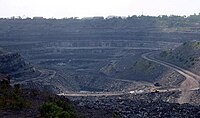
Photo from wikipedia
Coal spontaneous combustion in gob often induces gas explosion accidents. To solve the frequent occurrence of gas and coal spontaneous combustion (GCSC) symbiotic disaster of highly gassy and spontaneous combustion-prone… Click to show full abstract
Coal spontaneous combustion in gob often induces gas explosion accidents. To solve the frequent occurrence of gas and coal spontaneous combustion (GCSC) symbiotic disaster of highly gassy and spontaneous combustion-prone short-distance coal seams, the stope space of a complex working face formed by the old gob above and the coal seam mined below in Hengda Mine is divided into three zones, a completely connected zone, a partially connected zone, and an unconnected zone, according to the connectivity degree of fractures. A numerical model is established to study the relationship between gas drainage and coal spontaneous combustion. The effects of ventilation flux in the working face, gas drainage flow in the upper corner, gas drainage flow in the high-drainage roadway, fracture grout sealing, and nitrogen injection flow on the airflow field, gas concentration field, oxygen concentration field, and the temperature field in the completely connected and partially connected zones are analyzed. A multifactor interaction relationship under the conditions of ventilation, gas drainage, and nitrogen injection is revealed, and a multipoint and zoning coordinated prevention method for the GCSC symbiotic disaster is proposed. On the basis of the proposed method, the gas drainage flow in the high-drainage roadway and corner pipe of 5333(B) working face are determined to be 45.4 and 112.1 m3/min, respectively, and the total nitrogen injection flow in the upper gob and the lower gob are 350 and 640 m3/h, respectively. The upper corner gas concentration and the return roadway maximum gas concentration are lower than 0.8% during the stoping process, and there is no spontaneous combustion risk of the gob residual coal, thus reducing the greenhouse gas emission and realizing safety mining. This study is conducive to facilitate the realization of the goal of carbon neutrality and peak carbon dioxide emissions.
Journal Title: ACS Omega
Year Published: 2022
Link to full text (if available)
Share on Social Media: Sign Up to like & get
recommendations!